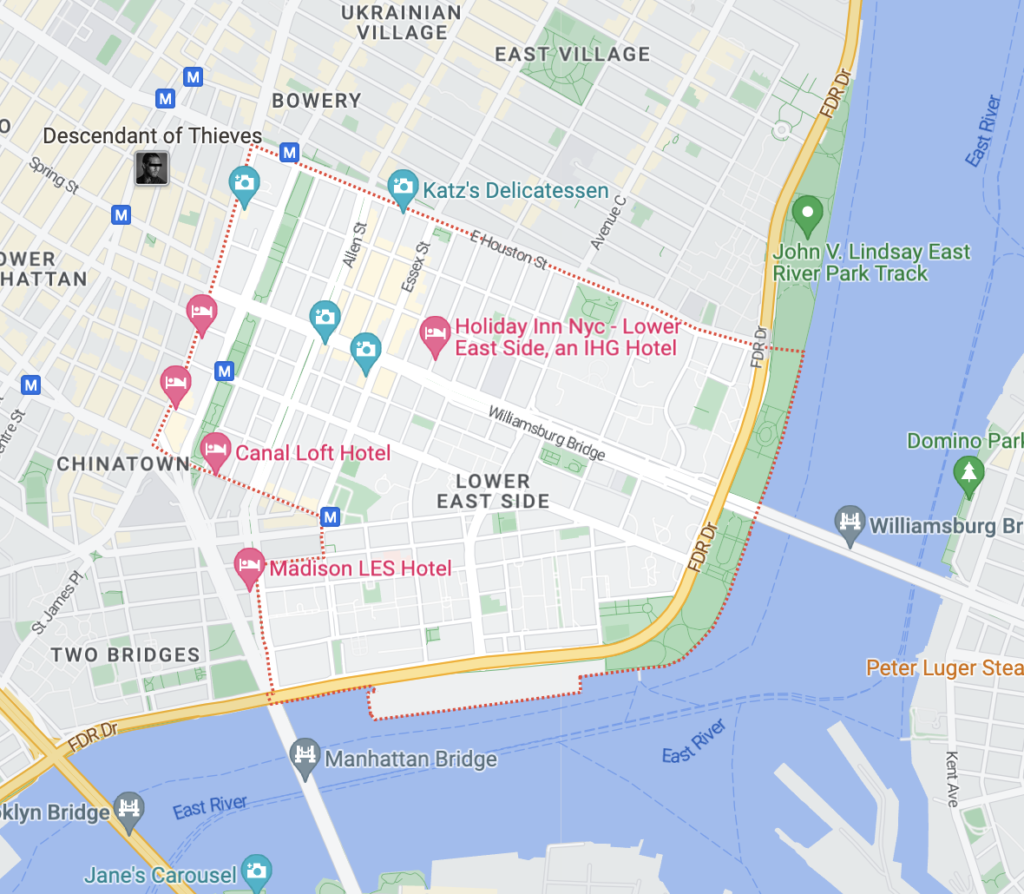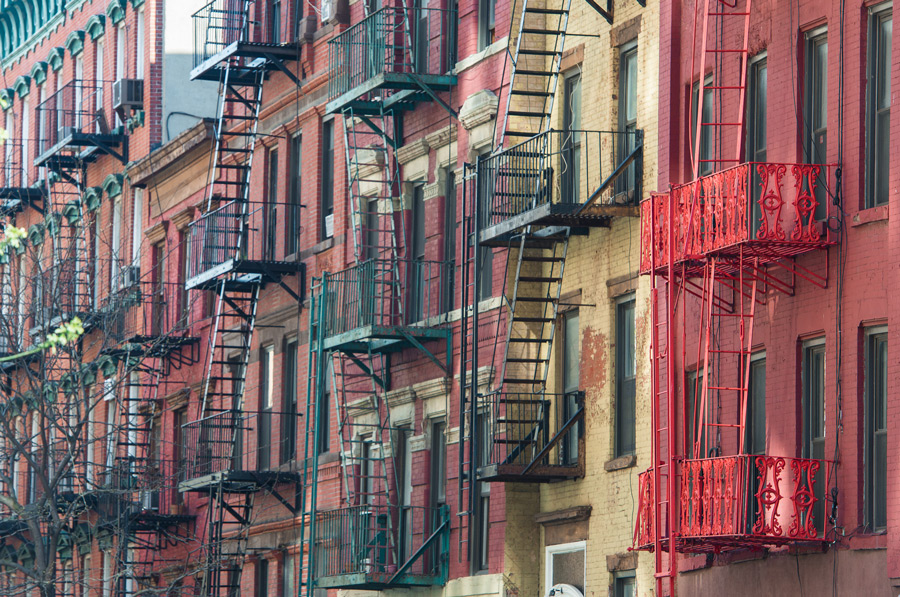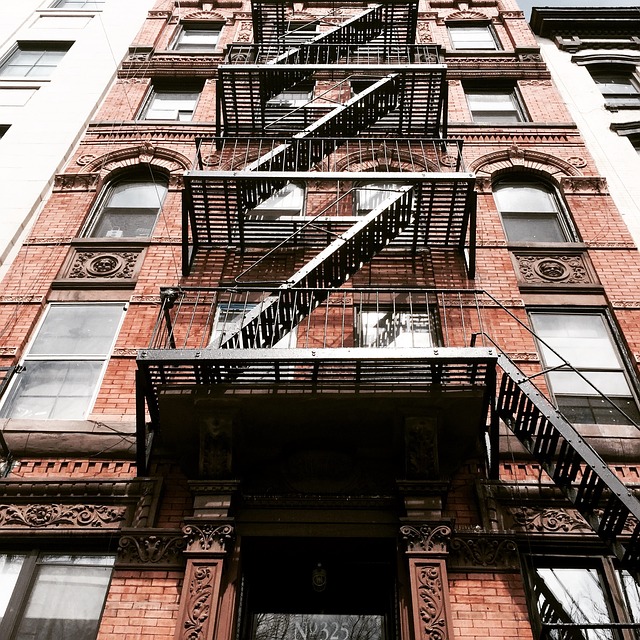The East Village, to be specific. Just one of a multitude of colorful micro villages that together make up the Lower East Side in New York City.
Although the Lower East Side has a reputation as a gritty, dangerous neighborhood where American punk rock and new wave music was born, it has undergone rapid gentrification in the last twenty years and gotten a lot safer. In fact, many famous people, including the likes of Jon Stewart, call it home.
Just how safe is it? If you’re reading this, you’re interested in the answer to that question. The Lower East Side can still seem sketchy, but it’s actually become quite trendy and expensive.
This article will explore the Lower East Side neighborhood in depth and answer definitively the question: is the Lower East Side safe?
Breaking Boundaries
The Lower East Side is located in Manhattan, the most well known borough in New York City, though not the most populous.

The recognized boundaries of the Lower East Side are East 14th Street in the north and Fulton and Franklin Streets on the south side. Broadway and Fulton Street are to the west and finally the East River to the East. So part of it is a waterfront neighborhood!
These boundaries encompass the micro neighborhoods of Chinatown, East Village, Little Italy, The Bowery, Alphabet City and NoLita.
Lower East Side History
Before it was settled, the area now known as Lower East Side was just marshlands where the Lenape tribe fished and hunted. In the late seventeen hundreds, it was settled by the Dutch. Their small colony was called New Amsterdam and consisted mostly of farms. From its earliest days to the present, the LES has been a microcosm of the immigrant experience in America, evolving through various phases of settlement, economic change, and cultural transformation.
Fun Fact! The name for the micro- neighborhood today known as “The Bowery” derives from the Dutch term ‘bouwerif’ which is a word used to describe plantations and large farms.

The East Village has evolved from those days. In the early days of New York City, immigrants were cramped in tenement buildings there. By the 1930s, the neighborhood had developed a reputation for radical and anarchist politics.
A major turning point was the 1960s, when artists, beat poets, hipsters and musicians started moving in. That’s when it first developed a reputation as an artistic and cultural hub. Then it started a steady decline. But that decline has turned around and now it is one of the trendiest neighborhoods in New York City! Read on to find out how and why.
Statistical Stories
The population of the Lower East Side varies depending on your definition of the boundaries. It can range from around 52,000 to 72,000 people.
Hispanics are the leading population base, making up almost forty percent. In second place are Asians which make up close to a quarter of the population. Makes sense, since the Lower East Side includes Chinatown.
Asians are followed by whites, who make up around twenty two percent. Ten percent are African-American. The rest of the population of the Lower East Side identify as other or mixed race.
Males outnumber females by an extremely small margin. The white population in the area has increased eighteen percent and Asians by ten percent. Similarly, the Latino population has seen a decline of ten percent.
The average annual income of the population is fifty-three thousand dollars a year. This is a little below the national average, which is just under seventy thousand a year. That’s individual income. Household median income is under forty thousand a year, and fourteen percent of residents live in poverty.
Thirty percent of residents of the Lower East Side have not completed high school. Another twenty five percent possess some sort of Bachelor’s Degree. Only twelve percent have a master’s degree.
The Lower East Side is home to only a small percentage of families who have children. Fifteen percent. Only thirteen percent of residents are under the age of 18. Twenty percent are above retirement age. The rest fall in the 18-65 adult demographic.
Gentrification and Preservation
Beginning in the mid-2000s, the LES experienced rapid gentrification, leading to significant social and economic changes. Rising property values and the influx of wealthier residents have transformed the neighborhood, prompting efforts to preserve its historic character. The National Trust for Historic Preservation listed the LES as one of America’s Most Endangered Places in 2008, highlighting the need to balance development with the preservation of the neighborhood’s rich cultural heritage.
Today, the LES remains a testament to New York City’s enduring role as a melting pot of cultures and a beacon for new Americans. Despite its evolution, the neighborhood continues to reflect the dreams, challenges, and achievements of generations of immigrants who have called it home.
For a more detailed exploration of the LES’s history, including its early settlement, immigrant waves, and cultural landmarks, the Tenement Museum offers extensive resources and tours that bring the neighborhood’s past to life.
Real Estate Stats For Lower East Side
The real estate market in the Lower East Side (LES) of Manhattan, NYC, has shown significant trends and changes as of late 2023 and into 2024. Here’s a comprehensive overview based on the latest available data:
Lower East Side Market Overview
- Median Listing Home Price: As of [monthyear[, the median listing home price in the LES was $999K, marking a 16.9% increase year-over-year. The median listing home price per square foot stood at $1.7K, while the median home sold price was $1.1M.
- Market Type: The LES is currently considered a buyer’s market, indicating that the supply of homes exceeds the demand. This is a shift towards more favorable conditions for buyers, with homes selling for approximately 3.04% below the asking price on average in December 2023.
- Sale-to-List Price Ratio: The sale-to-list price ratio in the LES was 99.2%, with a slight year-over-year decrease of 0.75 points as of December 2023. This suggests that homes are selling close to their listing prices, though slightly less than the previous year
A whopping eighty-four percent of residents rent their dwellings as opposed to just sixteen percent who own. This could be due to the average median price of buying a house being close to a cool million dollars or more.
Renting a studio apartment or one bedroom, on average, costs two thousand, twenty five hundred dollars a month. It can get up to four thousand a month. The area is classified as “dense urban”. In general, the rent is slightly cheaper than other parts of Manhattan.
Available real estate ranges from the old tenements, which are now walk-up apartments, to the fancy-shmancy high-rise condominiums that have popped up – pun intended – since gentrification intensified.
In conclusion, the LES real estate market is currently favoring buyers, with a notable increase in home values and a slightly cooling market as indicated by the sale-to-list price ratio. The neighborhood’s appeal is further enhanced by its excellent schools, amenities, and strong transportation links, despite some environmental risks that prospective buyers and renters should consider.
Lower East Side Transportation
In general, The Lower East Side is very walkable. There are also plenty of bike lanes. However, the biggest complaint of most residents is that subway access is limited in some parts.
There are some subway lines which serve the area. The B. D. F, J and Z lines are all represented at various stations. There are also plenty of bus lines. Plus, you can pick up the ferry at the East River station! The commute to Wall Street is particularly easy and just takes 20-25 minutes. Rockefeller Center in Midtown, which is four miles away in the opposite direction, also takes just 25 minutes.
Lower East Side Schools
Education is plenty available in the Lower East Side. A majority of schools are A+ rated. Most Lower East Side schools are a part of District 1, which has a reputation for being one of the most culturally diverse districts.
Public Schools include Stuyvesant High School and P.S. 110 Florence Nightingale, which is noted for its diverse student body and good parent involvement. There’s also Lower East Side Preparatory High School, which is known for its high academic standards, demanding curriculum and strong college acceptance record.
Private and Charter Schools include Regis High School and Manhattan Charter School. There is also Girls Prep Lower East Side, which has a strong academic culture and teaches young girls to speak their mind.
One unique advantage to schools on the Lower East Side is that they are not zoned, which means students can apply to any of the schools in the district.
The NYU campus is also not far from the Lower East Side, providing the neighborhood with a youthful vibe.
Things To Do In Lower East Side?
One unusual museum takes advantage of the rich historical significance of all the tenements in the neighborhood. The Tenement Museum lets you experience what life was like for the millions of immigrants who settled in the tenements.
The only museum designated specifically for contemporary art is in the Lower East Side. It’s called The New Museum and it is located in the Bowery, an oasis in a desert of brick buildings. Not only is it a cultural center, it is also an architectural contribution to the New York City landscape.
Like art? The Lower East Side is the former stomping grounds of legendary artists like Jean-Michel Basquiat. On the Lower East Side you will find a plethora of art galleries, many in close proximity to the New Museum.
Like nightlife? Live music rocks the Lower East Side every night of the week. Notable venues include Arlene’s Groceries, Mercury Lounge, Bowery Ballroom and Bowery Electric. Numerous punk rock and new wave artists like Talking Heads and Blondie made their names nearby at the now-defunct but never forgotten CBGB’s.
CBGB’s is now a high-end fashion store. The times, they do-a change.
Like food? One of the most historical landmarks in all of New York City: Katz’s Jewish deli. It wouldn’t be New York City without a Jewish deli. You’ll leave with a very satisfied belly. The sandwiches are ginormous! Katz’s Deli is actually just a two minute walk from Arlene’s Groceries and is open 24 hours.
Other landmark food spots include Russ and Daughters appetizers and Essex Street Market.
But Is Lower East Side Safe?
On the whole, the Lower East Side is considered one of the safer neighborhoods in New York City. Because of the young crowds, the area really comes alive at night. It may seem rowdy and crowded, but that actually makes it safer to walk around at night.
Of course, the flip side of this is that in crowded areas, you do have to be aware of the risk of pickpockets and keep your wits about you. Common advice for safety in any major metropolitan, high traffic area.
The area is patrolled by the 7th Precinct of the New York City Police Department.
Fun Fact! The 7th Precinct is the second-smallest precinct in the city, clocking in at only 0.62 square miles.
According to the precinct, crime has decreased significantly in the area. Almost sixty five percent in the last twenty years. The rate of violent crimes is less per capita than the rest of the city. Property crime is lower too but still somewhat of a problem, especially burglary.
In recent polls, fifty percent of respondents say that police in the area are visible but somewhat slow to respond. However, two thirds of respondents say they feel very safe and that crime doesn’t affect them much. In addition, forty three percent say they feel extremely safe walking alone, day or night.
Hearing From Residents
Residents say the best words to describe the people who live in the area are ‘loud’ and ‘eclectic’. Half of residents say there is a good sense of community. Their top two tips for newcomers are to show good manners and be aware of your surroundings.
Overall, residents describe the Lower East Side as very united and close and find the neighborhood uplifting and inspiring.
Here’s one last pro tip: Despite what you have seen in this article, never say ‘in the Lower East Side’. Say ‘on the lower east side’. You’ll fit right in.

Born and raised amidst the hustle and bustle of the Big Apple, I’ve witnessed the city’s many exciting phases. When I’m not exploring the city or penning down my thoughts, you can find me sipping on a cup of coffee at my favorite local café, playing chess or planning my next trip. For the last twelve years, I’ve been living in South Williamsburg with my partner Berenike.

